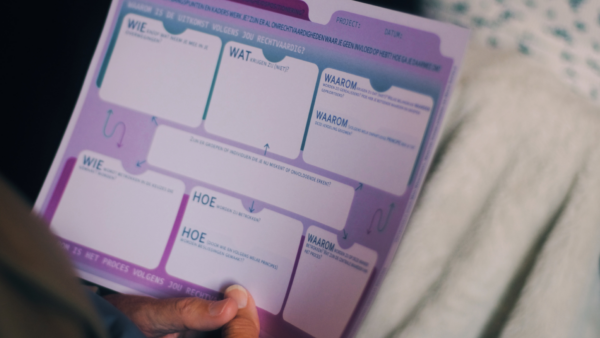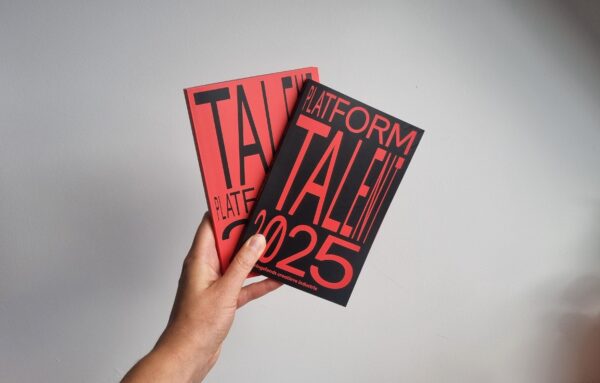

Changes #1: Looking ahead
Like many other institutions and fellow cultural funds, the Creative Industries Fund NL is spending the current period working on plans for the 2025-2028 policy period. What are important trends in the field? What needs extra attention? What should we do differently? We look both back and ahead with executive director Syb Groeneveld. In the coming weeks, colleagues will also shine their light on the changes they expect within their domains in the coming years.
26 October 2023
What developments are you seeing in the field?
‘In the past few years, the Covid pandemic of course had a major impact on everything and everyone in society. Much has changed in how we operate since March 2020, although it still remains a bit unclear exactly what the long-term consequences are, for instance for cultural production and participation, hybrid forms of working and collaborating, and new innovative funding combinations. That’s why the Creative Industries Fund NL is in permanent dialogue with representatives from the design, architecture and digital culture fields about changes within their discipline and what would be a balanced, effective and fair range of tools for the Fund to provide. Applying the codes for fair practice, governance and diversity and inclusion is an important part of that. These need to be embedded more solidly in the sector. We have a role to play in that, along with parties like Platform ACCT and industry organizations.’
And what’s going on at the level of the disciplines?
‘In the design discipline, circularity and sustainability continue to be the leading themes. In the slipstream of these topics, we are seeing more applications from subdisciplines such as social design, bio design and food design, in addition to for instance animation and exhibition design. In just a few years, the number of applications submitted to the Design Grant Scheme has increased by some forty percent, now numbering more than 400. This is putting a lot of pressure on our advisors and colleagues. In 2024 we shall launch a complementary scheme to give more room for the theme of sustainability and circularity. This is also important with respect to preserving the quality of the immediate living environment as the demand for housing continues to grow, and with energy neutrality as a major societal challenge. We are working with local architecture centres, Het Nieuwe Instituut, CRa, the relevant ministries and others to determine how we can address this theme more effectively, in a dialogue with civil society. Many of the projects we support show a gaping hole between policy, knowledge and implementation, which remains palpable in a trust-based collaboration between the (decentralised) government, citizens and designers. The call to create new perspectives, for instance through design-based research and impact studies, remains very important here.
Digital culture is the domain where the continually changing relationship between society and culture is interrogated, visualised or designed. Developments in this field happen quickly, making digital culture a discipline that is always on the move. Consider for instance media art, games, AV performances, VR, XR, AI, worldbuilding, creative coding, sensory storytelling, art-science, robotics, post-humanism and internet culture. In addition to our Digital Culture Grant Scheme, the Creative Industries Fund NL is working with the Dutch Film Fund in the Immerse\Interact Grant Scheme, in response to the importance of high-grade immersive and interactive productions. Upscaling, a greater visibility, and a broader base of makers and producers is essential in this domain.
Immerse\Interact
In the coming years the Fund will take on the coordinating role for the Immerse\Interact Grant Scheme, and we shall augment the scheme with a distribution facility. Given these developments, it is a very good thing that the Creative Industries Immersive Impact Coalition, funded by the National Growth Fund, will launch at the end of 2024. This programme will support scalable forms of immersive productions. We are curious to see how this ambitious plan will be elaborated further within the sector. For now, the Fund’s resources are too limited to fully support the many and often very costly projects, which require a long production time and are characterised by interdisciplinary collaboration throughout the chain, from development to presentation to distribution. If we’re not careful, a talented group of makers may decide to quit and pursue other professional practices instead – while the Netherlands actually has quite a reputation internationally in terms of high-quality XR/VR/A productions. Just look at this year’s Venice Immersive Competition, where five Dutch (co-)productions were selected.

Incidentally, interdisciplinarity is increasingly part of the fabric of the disciplines we support. Which really isn’t new: everyone is familiar with the Bauhaus movement of more than one hundred years ago, which influenced design, art and architecture. And in that same period, a journal like Wendingen devoted attention not just to architecture but also to visual and applied arts, and to the crossovers between them. I would be worried about the individual disciplines if there wasn’t any interdisciplinarity. It would mean that the field isn’t developing and is not looking around. It is important for us to remain in a permanent dialogue with the field and with for instance fellow cultural funds, so that we can remain in tandem with new developments. We have done so explicitly in recent years, for instance with the Experiment Grant Scheme, with the series of Research, Act & Reflect open calls, the scout nights and the Platform for Design-based Learning programme. And we shall continue to do so, also in the plans for the 2025-2028 policy period.’

Do you also work with other national cultural funds to stimulate interdisciplinary projects?
‘Certainly, we work with all of the funds. As said, we are working with the Dutch Film Fund to implement the Immerse\Interact Grant Scheme, and in 2019 we launched the Upstream Grant Scheme: Music x Design with the Performing Arts Fund NL. In recent years we worked with the Cultural Participation Fund twice to launch the Open Call Contemporary Use of Crafts, and since many years we partner the Dutch Foundation for Literature in the Open Call Literature on Screen. With the Mondriaan Fund we offer designers and artists a rather special residency place in Arita, Japan. And all the funds together manage a residency in Theo van Doesburg’s French studio home, which is very much in keeping with his own interdisciplinary practice. Another good example of a sector-wide initiative is Innovatielabs, for which we work with CLICKNL and which supports projects that seek to increase the sector’s resilience. The results of these projects can be viewed untill 29 October during the current Dutch Design Week at the exposition in the Klokgebouw, by the way.
The funds also collaborate to reach the Caribbean part of the Kingdom and to boost the development of the infrastructure there. Two other wonderful examples of collaboration with a view to internationalisation are Building Beyond, which is an educational programme that we are developing with the Prins Claus Fonds. Our Open Call Hidden (Hi)stories is part of a knowledge exchange programme with Het Nieuwe Instituut that focuses on opening up hidden stories from the Dutch colonial past and post-colonial present.’

Are there any major challenges that may impact the Fund’s future working methods?
‘During the Covid pandemic we saw a substantial increase in the number of applications, and the level has remained high. We expect that the pressure on the grant schemes is here to stay. The Fund’s name recognition has increased in all parts of the country, disciplines are expanding, we are reaching a more diverse group of makers, and the added value of design power is recognised by more parties. That is why we are seeking, at different levels, to simplify the procedures regarding grant applications, both internally and for advisors and applicants. The goal is to organise the application, development and accountability process more on the basis of trust. This should lessen the burden for everyone. In that respect we are curious to hear the recommendations of the Review Committee which we are due to receive soon, and the report by the Council for Culture.’

How does the pressure on the grant schemes affect the Fund’s accessibility?
‘The fact that most of our grant schemes are currently overtaxed does put us in a bit of a fix. The national cultural funds, so including the Creative Industries Fund, have an important responsibility within the cultural infrastructure to ensure the widest possible reach for the cultural and creative sector. This is creating something of an accessibility dilemma. On the one hand we wish to cater to the widest and most diverse possible group of applicants. But at the same time we need to limit the number of applications if we are to keep our task manageable, and to maintain an acceptable proportion of rejections within each grant scheme. We need to avoid having too many proposals that are assessed positively but which we cannot offer a grant because we’ve run out of budget. So we want to continue catering to the full breadth of the work field, which implies attention for all the different voices within it. The pressure on our grant schemes demands a clearer demarcation of eligibility, so that we can use our limited resources to achieve the biggest possible impact for the sector. How to do so? That’s what we will figure out in the coming months.’
The Creative Industries Fund NL will present its 2025-2028 policy plan in February 2024. This report will be written based on the 2025-2028 policy framework (link in Dutch) that the Ministry of Education, Culture and Science presented to the Fund, and on the basis of numerous conversations and meetings in the design field.
Photo above: executive director Syb Groeneveld during the opening of the exhibition The Rest Is Still Unwritten in the Portiersloge during the Dutch Design Week 2023. Photo: Clara Gus







